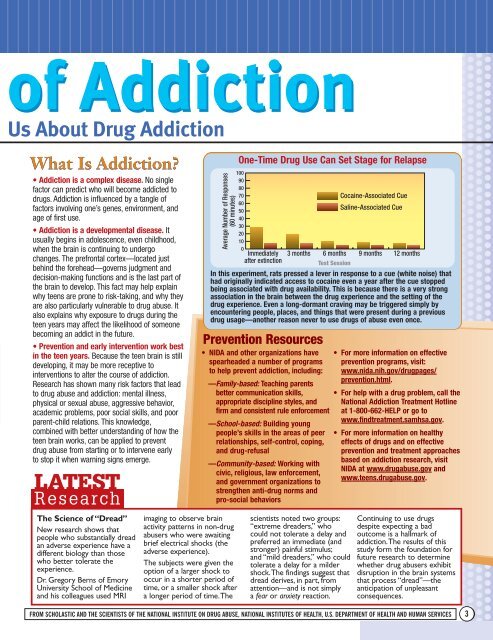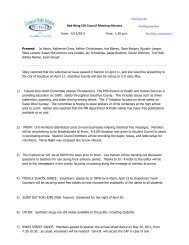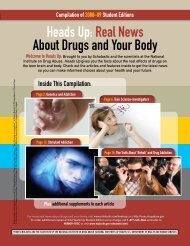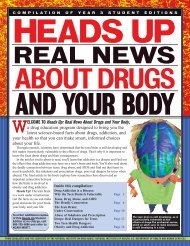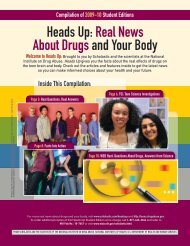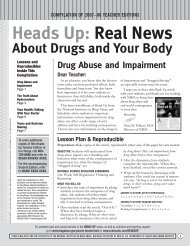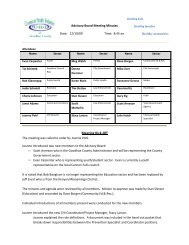Heads Up: Real News - Scholastic
Heads Up: Real News - Scholastic
Heads Up: Real News - Scholastic
Create successful ePaper yourself
Turn your PDF publications into a flip-book with our unique Google optimized e-Paper software.
of Addiction<br />
Us About Drug Addiction<br />
What Is Addiction<br />
• Addiction is a complex disease. No single<br />
factor can predict who will become addicted to<br />
drugs. Addiction is influenced by a tangle of<br />
factors involving one’s genes, environment, and<br />
age of first use.<br />
• Addiction is a developmental disease. It<br />
usually begins in adolescence, even childhood,<br />
when the brain is continuing to undergo<br />
changes. The prefrontal cortex—located just<br />
behind the forehead—governs judgment and<br />
decision-making functions and is the last part of<br />
the brain to develop. This fact may help explain<br />
why teens are prone to risk-taking, and why they<br />
are also particularly vulnerable to drug abuse. It<br />
also explains why exposure to drugs during the<br />
teen years may affect the likelihood of someone<br />
becoming an addict in the future.<br />
• Prevention and early intervention work best<br />
in the teen years. Because the teen brain is still<br />
developing, it may be more receptive to<br />
interventions to alter the course of addiction.<br />
Research has shown many risk factors that lead<br />
to drug abuse and addiction: mental illness,<br />
physical or sexual abuse, aggressive behavior,<br />
academic problems, poor social skills, and poor<br />
parent-child relations. This knowledge,<br />
combined with better understanding of how the<br />
teen brain works, can be applied to prevent<br />
drug abuse from starting or to intervene early<br />
to stop it when warning signs emerge.<br />
LATEST<br />
Research<br />
The Science of “Dread”<br />
New research shows that<br />
people who substantially dread<br />
an adverse experience have a<br />
different biology than those<br />
who better tolerate the<br />
experience.<br />
Dr. Gregory Berns of Emory<br />
University School of Medicine<br />
and his colleagues used MRI<br />
Average Number of Responses<br />
(60 minutes)<br />
imaging to observe brain<br />
activity patterns in non-drug<br />
abusers who were awaiting<br />
brief electrical shocks (the<br />
adverse experience).<br />
The subjects were given the<br />
option of a larger shock to<br />
occur in a shorter period of<br />
time, or a smaller shock after<br />
a longer period of time.The<br />
One-Time Drug Use Can Set Stage for Relapse<br />
100<br />
90<br />
80<br />
70<br />
60<br />
50<br />
40<br />
30<br />
20<br />
10<br />
0<br />
Immediately<br />
after extinction<br />
3 months 6 months<br />
Test Session<br />
Cocaine-Associated Cue<br />
Saline-Associated Cue<br />
9 months<br />
12 months<br />
In this experiment, rats pressed a lever in response to a cue (white noise) that<br />
had originally indicated access to cocaine even a year after the cue stopped<br />
being associated with drug availability. This is because there is a very strong<br />
association in the brain between the drug experience and the setting of the<br />
drug experience. Even a long-dormant craving may be triggered simply by<br />
encountering people, places, and things that were present during a previous<br />
drug usage—another reason never to use drugs of abuse even once.<br />
Prevention Resources<br />
• NIDA and other organizations have<br />
spearheaded a number of programs<br />
to help prevent addiction, including:<br />
—Family-based: Teaching parents<br />
better communication skills,<br />
appropriate discipline styles, and<br />
firm and consistent rule enforcement<br />
—School-based: Building young<br />
people’s skills in the areas of peer<br />
relationships, self-control, coping,<br />
and drug-refusal<br />
—Community-based: Working with<br />
civic, religious, law enforcement,<br />
and government organizations to<br />
strengthen anti-drug norms and<br />
pro-social behaviors<br />
scientists noted two groups:<br />
“extreme dreaders,” who<br />
could not tolerate a delay and<br />
preferred an immediate (and<br />
stronger) painful stimulus;<br />
and “mild dreaders,” who could<br />
tolerate a delay for a milder<br />
shock.The findings suggest that<br />
dread derives, in part, from<br />
attention—and is not simply<br />
a fear or anxiety reaction.<br />
• For more information on effective<br />
prevention programs, visit:<br />
www.nida.nih.gov/drugpages/<br />
prevention.html.<br />
• For help with a drug problem, call the<br />
National Addiction Treatment Hotline<br />
at 1-800-662-HELP or go to<br />
www.findtreatment.samhsa.gov.<br />
• For more information on healthy<br />
effects of drugs and on effective<br />
prevention and treatment approaches<br />
based on addiction research, visit<br />
NIDA at www.drugabuse.gov and<br />
www.teens.drugabuse.gov.<br />
Continuing to use drugs<br />
despite expecting a bad<br />
outcome is a hallmark of<br />
addiction.The results of this<br />
study form the foundation for<br />
future research to determine<br />
whether drug abusers exhibit<br />
disruption in the brain systems<br />
that process “dread”—the<br />
anticipation of unpleasant<br />
consequences.<br />
FROM SCHOLASTIC AND THE SCIENTISTS OF THE NATIONAL INSTITUTE ON DRUG ABUSE, NATIONAL INSTITUTES OF HEALTH, U.S. DEPARTMENT OF HEALTH AND HUMAN SERVICES 3


